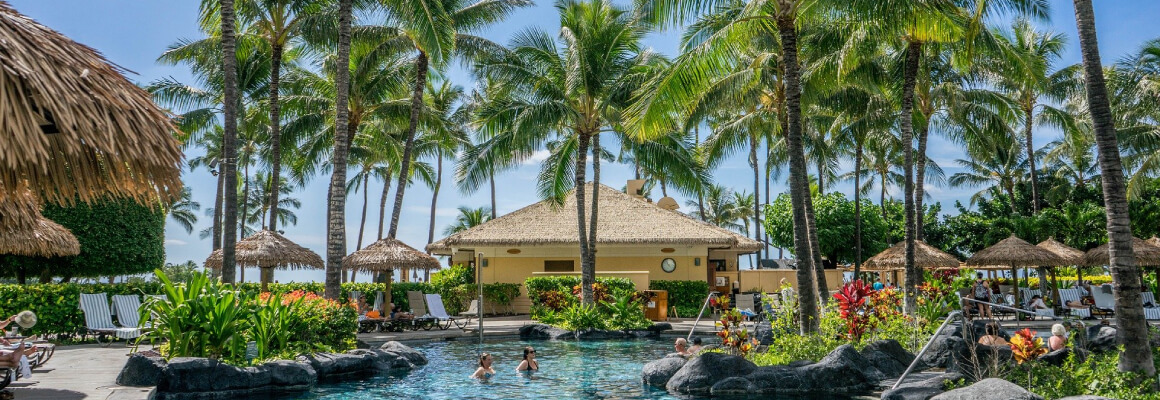
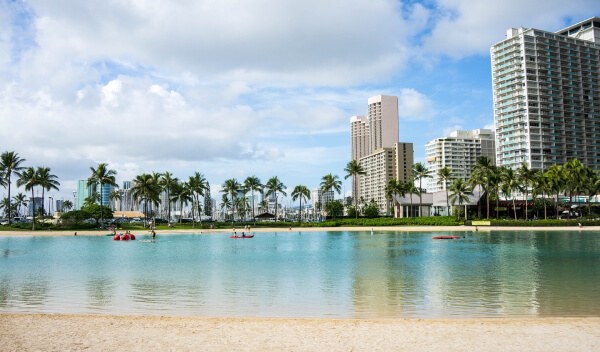
Every morning when I'm in Waikiki, I just can't wait to wake up and take my morning walk to get the blood flowing. If you want the simple version, just walk across the Ilikai foyer, down the walkway, around the lagoon and heads towards Diamond Head till you hit sand. Then left, right, left on Lewers Street and right on Kalakaua Avenue and head right to Kapi'olani Park and return.
Its about a 1 hour round trip walk and even in the morning, you will be delighted with all the characters you will see from all over the world. If you want the historical version of the walk and what was once there, read below and each surf board statue you run into will explain the history of Waikiki.
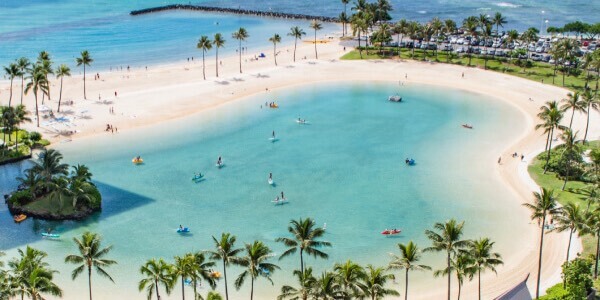
The third stream in Waikiki, Pi'inaio entered the sea here. The mouth of the Pi'inaio was a large muddy delta intersected by several small tributary channels. The sea teemed with fish, eels, shrimp, lobster, octopus, crab and seaweed. The fishermen caught so much fish that they became known as "human fishnets." As recently as the 1930s, residents of Kalia described the area as "one of the most productive seafood producing bays ever known." There would be thousands of white crabs on the beach and catch them by the bucket full. Of course today, Waikiki is basically fished out. Walk down the walkway and around the lagoon past the Hilton where the park is located.
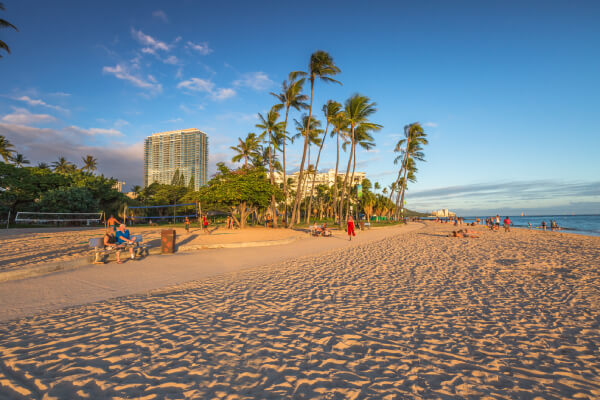
Olympic swimming champion Duke Kahanamoku (1890-1968) family owned most of the 20 acres which the Hilton Hawaiian Village now occupies. It is said that it was here in Kalia that a husband waited patiently for the return of his wife who had been wooed away by a rival chief in Maui; hence, the name Kalia or "waited for." Duke's grandfather Ho`olae Paoa, was deeded the land by King Kamehameha III in the great Mahele of 1848. The Great Mahele was a dividing of the lands among the king, the chiefs, and the commoners. It also allowed foreigners to own land in the Kingdom for the first time. The Paoas were a large `ohana (family). More than 100 were living in the area at the time. The families had their gardens and grew enough taro and sweet potatoes to meet their needs. Being excellent fishermen, they never were short of the bounties of the seaweed, squid, shrimp, crab, lobster and varieties of fish.. Duke learned to swim in these waters the old-fashioned way: by being thrown into the water to sink or swim!
He learned so well that in 1911 he broke the world's record for the 50-yard and 100-yard sprints in the first AAU swim meet held in Hawai'i. In 1912 he was named to the U.S. Olympic team and won the gold medal in the 100-meter freestyle. This area is also where he learned to become a champion surfrider and Hawaiian outrigger canoe paddler. Hawaiians say you can still feel the "mana" (spirit) of Duke and the Paoas here on their former lands. Continue walking down the beach
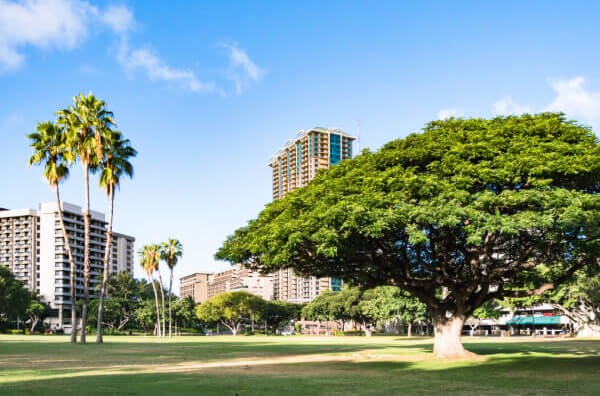
Right here in 1897 you would be standing on Waikiki's largest fish pond, the Ka'ihikapu, which encompassed 13 acres. All of today's Fort DeRussy on the mauka (toward the mountain) side of the road was covered with fishponds. There were hundreds of fishponds in Waikiki.
The fishponds were controlled by the chiefs, but maintained by the commoners. The fish grown in the ponds were mostly ama'ama or mullet and awa or milkfish, both of which adapted well to brackish water. The ponds were "royal iceboxes" with readily available food for guests. Ancient Hawaiians believed their fish ponds were inhabited by mo'o deities who were sometimes described as creatures with terrifying black bodies, 12 to 30 feet in length. Hawaiians believed they were the guardian spirits of fish ponds, who not only protected the caretakers but punished those who abused their responsibilities. The reclamation of Waikiki began here in Kalia when the U.S. military acquired 72 acres of land and started draining it in 1908 to build Fort DeRussy. It took over 250,000 cubic yards of sand and coral dredged from various O'ahu areas to cover Ka'ihikapua and its sister ponds in Kalia. The Hale Koa Hotel is used exclusively for U.S. military personnel and their dependents.
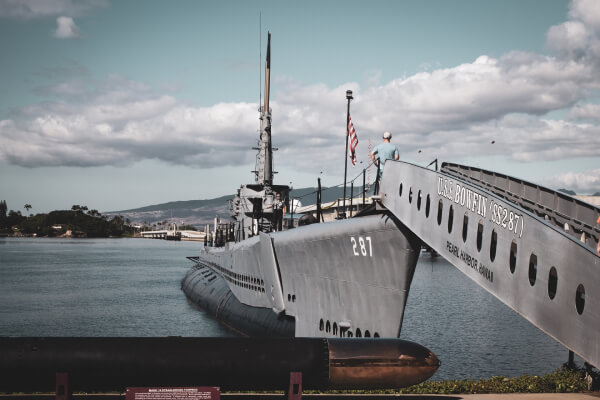
On this site stood the villa of Chun Afong, Hawai'i's first Chinese millionaire, who arrived in Honolulu in 1849. By 1855, he had made his fortune in retailing, sugar, rice and real estate and held the government monopoly on the opium license. Chun Afong was a member of King Kalakaua's privy council, and married Julia Fayerweather, a descendent of Hawaiian royalty, with whom he had 16 children, 13 of whom were daughters. He was the inspiration for Jack London's famous story, "Chun Ah Chun." His Waikiki villa occupied three acres of beautiful landscaped grounds. Here he entertained grand parties for royalty, diplomats, military officers and other dignitaries. In 1904 the U.S. Army Corps of Engineers purchased the property for $28,000 to make way for the construction of Battery Randolph and the no-longer-extant Battery Dudley to defend Honolulu Harbor from foreign attack. The battery consisted of two 14-inch guns, which could fire a 1,560 pound projectile over a range of 14 miles. It was constructed with reinforced concrete walls and a roof up to 12 feet thick. In 1969, the Army attempted to demolish Battery Randolph, but it resisted all efforts of the wrecking ball. The use of dynamite was rejected as too dangerous. One of the last important military fortifications of its time, it was dedicated on December 7,1976 as the home of the U.S. Army Museum of Hawai'i.
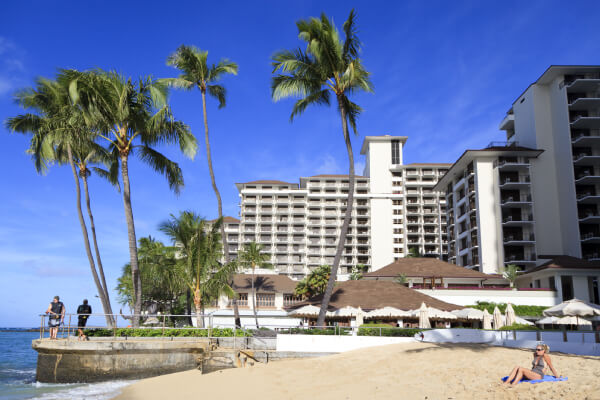
Waikiki long ago was viewed not only as a place of peace and hospitality, but of healing. There was great mana (spiritual power) in Waikiki. Powerful kahuna la'au lapa'au or physicians lived here. Throughout the 19th century Hawai'i's royalty also came here to heal. One of Waikiki's places of healing was this stretch of beach fronting the Halekulani Hotel called Kawehewehe (or the removal). The sick and the injured came to bathe in the kai, or waters of the sea. They might have worn a seaweed lei of limu kala and left it in the water as a symbol of the asking of forgiveness for past sins, which was believed to be the cause of many illnesses. Hawaiians still use the sea to heal their sores and other ailments. In 1912, a home here was converted to a boardinghouse known as "Grays-by- the -Sea." Its grounds later became the Halekulani. The beach is still known today as Gray's Beach. The natural sand-filled channel that runs through the reef makes it one of the best swimming areas along this stretch of ocean.
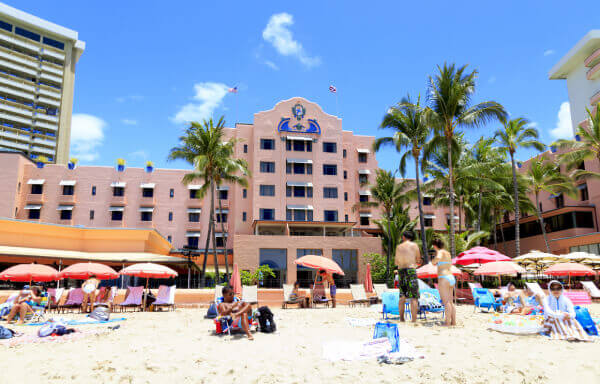
Here is where the royal coconut grove known as Helumoa once stood. It consisted of appx. 10,000 trees. According to legend, the first tree was planted in the 16th century by the great chief Kakuhihewa. Kamehameha the Great camped here with his generals as they began their conquest of O'ahu in the summer of 1795. They returned victorious from the battles in Nu'uanu Valley and made Waikiki the first capital of the Kingdom of Hawai'i.
This area was known as Pua'ali'li'i. King Kamehameha built a Western style stone house here. This residence was often occupied by his favorite wife Ka'ahumanu and her staff. Kamehameha ended Waikiki's nearly 400-year reign as O'ahu's capital when he moved his residence and headquarters to Honolulu because of its harbor and access to foreign trade and goods.
Later, the modest residence of Kamehameha V Lot Kapuaiwa, the grandson of King Kamehameha I, was built here. These lands were inherited by his half-sister, Princess Ruth, and later willed to Princess Bernice Pauahi, the last of the Kamehamehas. Her estate still owns this land today, and funds the Kamehameha Schools, which educates thousands of native Hawaiian children across the State. The Royal Hawaiian Hotel or "The Pink Palace" was built in 1927 at a cost of $5 million. With 400 lavishly decorated rooms and Spanish-Moorish style architecture, it was touted as the "finest resort hotel in America."
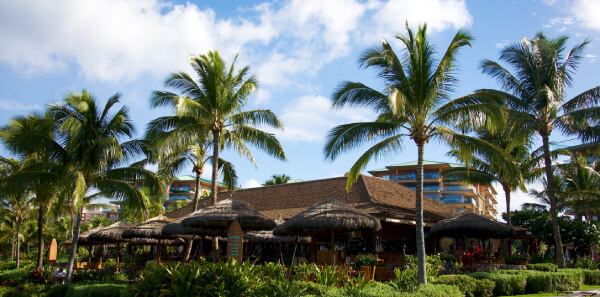
The 'Apuakehau ("basket of dew") stream emptied into the sea right here under your feet. The Apuakehau flowed through the middle of Waikiki until the completion of the Ala Wai Canal in 1928. The mouth of this stream carved out a channel in the sea bottom creating the surfing area known in ancient times as Kalehuawehe. The Paradise of the Pacific magazine said in January 1895, "A pretty little river runs through the village of Waikiki. It ripples gently along between the level banks through taro patches, rice and banana fields on its way to the ocean. Canoes glide along the shining surface. There are groups of native women and children catching shrimps in long narrow baskets, often stopping to eat a few."
Today this is a favorite spot for some of Waikiki's famed beach boys. This elite group got their start in the 1930s when the first Waikiki Beach Patrol was organized. They have been called "Waikiki's ambassadors," serving the needs of royalty, Hollywood celebrities, and the general public alike. Today, they are professionals licensed by the State of Hawai'i to teach surfing or canoe riding and must be regularly qualified in life-saving tests.
James Michener, author of "Hawaii" the best novel on Hawaii and a real "must read" said of the beach boys: "Without these remarkable people the island would be nothing. With them, it is a carnival. They are generous, courageous, and comical. They are perpetual adolescents of the ocean, the playboys of the Pacific."
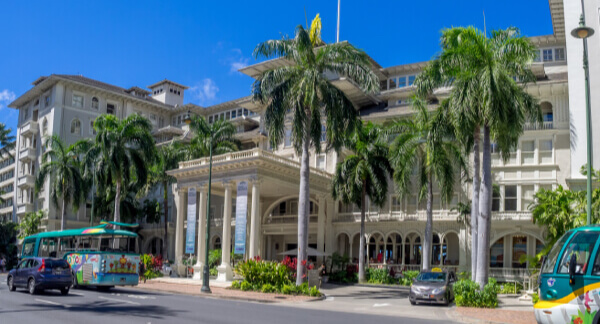
The first hotels in Waikiki were bathhouses, such as the Long Branch Baths, which began to offer rooms for overnight stays in the 1880s. This facility featured a toboggan slide 40 feet high, which propelled riders a hundred feet over the water.
The first beachside hotel, the Park Beach, was a converted home which offered 10 rooms, each equipped with a bath and telephone. The Moana Hotel, the "First Lady of Waikiki," which opened in 1901, established Waikiki as a resort destination. The four-story, 75 room structure was the tallest building in Hawaii. It sits on the area known in ancient times as Ulukou, or "kou tree grove." Kou is a wood highly prized for bowls and other eating implements.
Fifteen years after its opening the Moana added 100 new rooms in two wings that created this courtyard facing the sea. Under the banyan tree, Johnny Noble and his Orchestra delighted dancers and listeners. In 1935, Harry Owens and Webley Edwards inaugurated the famed radio program "Hawai'I Calls." It was beamed to Hawaiian music audiences for 40 years. At its peak in 1952, the weekly program was broadcast on 750 stations worldwide.
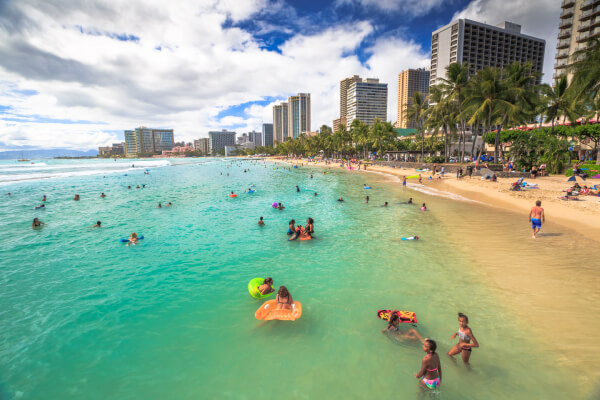
The Healing Stones of Kapaemahu. The plaquereads: "Wizard Stones of Kapaemahu Hawaiian legend says these stones were placed here in tribute to four soothsayers, Kapaemahu, Kahaloa, Kapuni and Kinohi, who came from Tahiti to Hawaii long before the reign of Oahu's King Kakuhihewa in the 16th century. The four were famed for their healing powers, before vanishing. The wizards transferred their powers to these stones. Department of Parks & Recreation City & County of Honolulu 1963") Legend says that these stones were brought into Waikiki from Waialae Avenue in Kaimuki, nearly two miles away. Waikiki was a marshland devoid of any large stones. These stones are basaltic, the same type of stone found in Kaimuki. Thousands of people were used to move these stones, which weighed up to 16,000 pounds during the night. How did they accomplish this with no wheeled vehicles or animals to help them is still a mystery. This wahi pana (or legendary site) was restored with the Assistance of Papa Henry Auwae, a traditional Hawaiian healer, and the Queen Emma Foundation 1997.
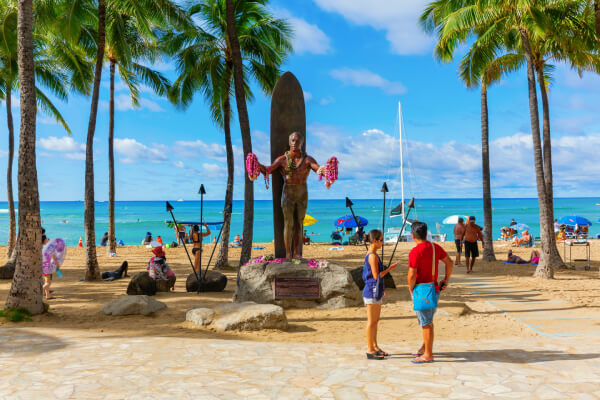
Duke Paoa Kahanamoku, August 24, 1890 - January 22, 1968. Raised in Waikiki, Duke was a full-blooded Hawaiian, who symbolized Hawaii to millions of people. He developed into an Olympic champion and the world's fastest swimmer. Between 1912 and 1932 he won three gold medals, two silver and a bronze in four Olympics. He is known as the "Father of International Surfing." Duke introduced surfing to the Eastern Seaboard of America, Europe and Australia. He became a hero when he saved eight lives from a capsized launch at Corona Del Mar, California in 1925 using his surfboard. A movie actor from 1925-1933, he was elected sheriff of Honolulu for thirteen consecutive terms from 1934-1960. He has been recognized as Hawaii's Ambassador of Aloha since 1962. "He has honored his name, he has honored his race, he has honored his state, he has honored us all."
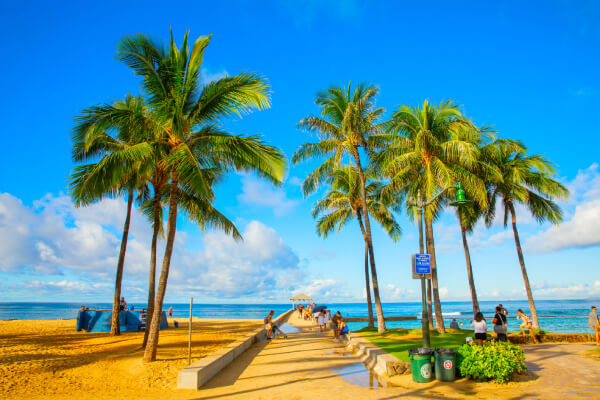
This stretch of beach (from the Kapahulu to Beach Center) is Kuhio Beach Park. It is named for Prince Jonah Kuhio Kalaniana'ole, Hawaii's second Delegate to the United States Congress. He served as Delegate from 1902 to 1922. He is best known for the passage of the Homes Commission Act, which provided Native Hawaiians 200,000 acres of land for homesteading. He was a Royalist and in 1895 joined an unsuccessful attempt to overthrow the Republic of Hawai'i and restore Quees Lili'uokalani to the throne. He was charged with treason and served one year in prison. He lived in a stately home, called Pualeilani or "Flower From the Wreath of Heaven" (Located across the street) and upon his death, the property, which included the beach, was given to the City. He is popularly remembered as Prince Cupid or as Ke Ali'I Maka'ainana (the Chief of the Commoners).
The low retaining wall offshore is called "Slippery Wall" because it is covered with fine seaweed that creates a very slick surface when wet. Young people often enjoy sliding on it. But it can be dangerous. It's best to avoid it. Actually the wall was built to keep the sand from eroding away, but it's always a losing battle. Every few years sand is brought in to rebuild the world's most famous beach.
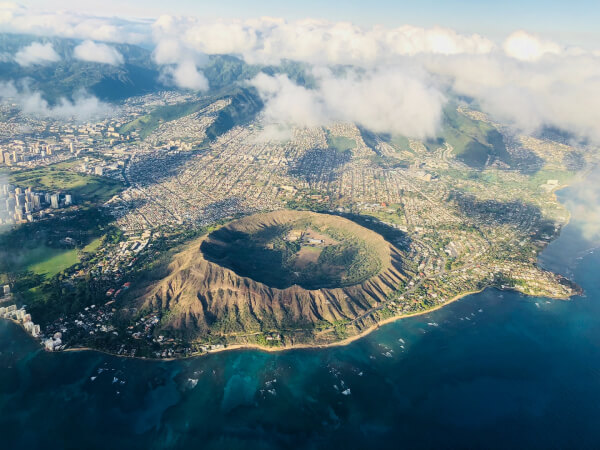
From ancient times Waikiki has been a popular surfing spot. Indeed, this is one of the reasons why the old chiefs made their homes and headquarters in Waikiki for hundreds of years. Though surfing has been called "the sport of kings," in ancient days everyone surfed - young and old, men and women, commoners and chiefs. Freed from working in the fields, the chiefs were the best surfers. Certain areas were reserved for them and death to the commoner who got caught riding a royal wave!
Not far from here, on the slopes of Diamond Head, was a temple that was dedicated to surfing. Temple priests would announce surf conditions to the villagers below by flying a kite. Surfs had their special names and the most famous in Waikiki was Kalehuawehe or "take off the lehua." It was so named when a legendary hero took off his lei of lehua blossoms and gave it to the wife of a ruling chief, with whom he was surfing. Romance and surfing often went together. Waikiki has the best summer waves in the world. The swells vary in height from 2 to 8 feet and the very, very rare 30 feet (in Steamer Lane). The rides can easily extend a hundred yards or so.
The longest ride recorded took place in 1917 when the great Duke Kahanamoku caught a wave 35-feet high and rode it to shore, a distance of a mile and a quarter. You are standing on what was the mouth of an old stream, the Kuekaunahi, one of three that flowed from the mountains and valleys of the Ko'olau Range down through the marshes of Waikiki to the sea. Waikiki was indeed a marsh; hence, its name "spouting water."
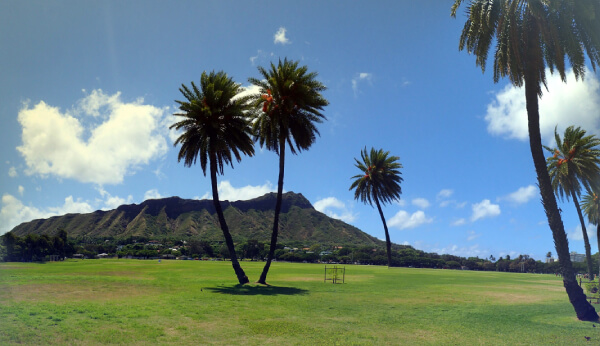
This section of Waikiki Beach contains four distinct areas: Outrigger Canoe Club, Sans Souci, Kapi'olani Park and Queen's Surf. The Outrigger Canoe Club Beach fronts the Club, which was founded in 1908 to revive surfing and canoe paddling, and promote other sports and activities. Sans Souci (from the French "without care") takes its name from a small hotel that once stood on the grounds now occupied by the Kaimana Beach Hotel. In 1893 the famed Scottish writer Robert Louis Stevenson spent five weeks convalescing at Sans Souci. He praised the hotel for its "lovely scenery, quiet, pure air, clear sea water, good food, and heavenly sunsets..." Next to San Souci is the War Memorial Natatorium, a monument to the 179 island men who lost their lives in World War I. This unique athletic facility, with its 100 meter salt-water pool (still the largest in the U.S.), opened in 1927. It has been partially restored, although the pool is no longer used.
Kapi'olani Park Beach is part of the 100-acre Kapi'olani Regional Park which was dedicated in 1877 by King Kalakaua in honor of his Queen Kapi'olani. The park's main feature was a horse-race track in early years. In ancient times, there were at least two temples or heiau located near the shoreline in this area. One was Kupalaha, at Queen's Surf Beach. It may have functioned in connection with the famed Papa'ena'ena heiau where it is believed the last human sacrifice was made by Kamehameha I in Waikiki. The other was Makahuna near the foot of Diamond Head, which was dedicated to Kanaloa, the god of the Seas, and was attended to by fishermen and seamen.
Hope you enjoyed your walk...also the Waikiki Zoo is actually a great surprise and is much better than you would expect. Most of those coupon books on the streets have a free admission coupon and it's well worth the visit.
Mahalo
WaikikiBeachRentals.com